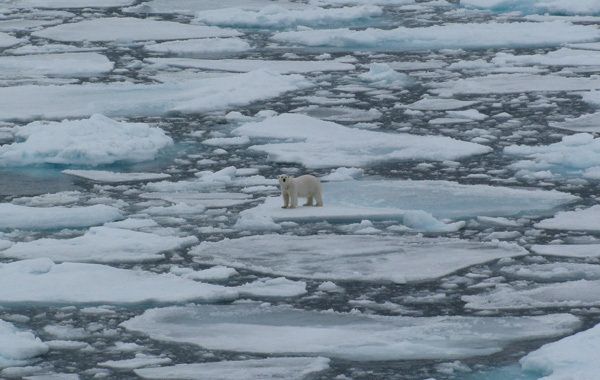
Over the last couple weeks, the climate blogosphere has been lighting up over a recent report that enormous plumes of methane are bubbling to the surface off the coast of eastern Siberia in Russia. (Original article in the Independent online.)
So, what does this mean? It's a lot of methane, to be sure. The discovery was first made in 2010 and estimated at over 7 million tons (roughly equivalent to the methane emissions from the rest of the whole ocean). Now scientists report even more methane coming up, in plumes over a kilometer wide, although they aren't estimating exactly how much more yet.
One of the researchers described the plumes in the Independent as "continuous, powerful and impressive seeping structures." I'm imagining a loose strand of gas bubbles rising up through the ocean to the surface, more like scuba diving CO2 emissions than Old Faithful. The authors use the term "ebullition" to describe the process -- a new word for me and an instant favorite.
Left unsaid in all this buzz, but nevertheless implied is the worry that human-caused global warming triggered the methane release. Buried deep under the seafloor of the Arctic Ocean is a reservoir of carbon called methane hydrates, methane gas trapped in a cage of ice. Some scientists estimate they hold more carbon than all remaining fossil fuel reserves combined.
IF these things melted and released all their methane, it would be catastrophic for climate change. Methane is more than 20 times as powerful as CO2 and a major contributor to climate change, typically from emissions from livestock and landfills. Could that be what these scientists discovered? Answer: No. Under closer examination, it turns out that although recent climate change has indeed warmed up the Arctic Ocean and a thin layer of the seafloor beneath it, it hasn't gotten anywhere close to where the methane hydrates lie buried 200 meters below the seafloor. Before human warming began, buried permafrost (permanently frozen mud) started about 25 meters below the seafloor. Now, rising sea temperatures have increased that depth to 26 meters below the seafloor. (A meter's not a lot, but it's incredible to me that our CO2 emissions have done anything at all below the floor of the Arctic Ocean -- more evidence that the effects of climate change are real and in progress.)
But let's dig a little deeper (pun intended). Where did these methane hydrates come from in the first place? Are they the source of the methane or not? And if we're not melting them, where are the methane plumes coming from?
I blogged on the mysterious methane hydrate back in April, but they're cool enough (last pun, promise) to warrant a second look. They're sensitive entities that can only exist under cold, high-pressure conditions, such as at or below the seafloor. Because they've got methane in them, you can burn them, which is why their nickname is "fire ice." The methane inside comes from ancient marine plankton that got buried over time in the mud and decomposed, eventually ending up at just the right temperature and pressure conditions to get trapped within a cage of ice.
Usually, methane hydrates exist 300-500 meters below the seafloor, but in the Arctic, where it's colder, they can exist at shallower depths, around 200 meters. This is what makes them more susceptible to warming. But the same researchers who discovered the plumes of methane calculate that even if humans keep on cranking up the Earth's thermostat for another 1000 years, we'll still only defrost the top 75 meters of seafloor, so they seem pretty safe for the time being.
But these methane hydrates aren't the only bits of methane buried beneath the ocean. The rest of the permafrost has methane trapped in it, too, even if it's not in the cool form of fire ice. And it appears to be this methane that's the source of the current ebullition.
Prior to 8000 years ago, this part of Siberia was actually land. But as sea level rose after the last ice age, the ocean flooded this part of the coast, putting the land under water, where it's been ever since. The researchers believe that the methane leaking out today is left over from the permafrost adjusting to being submerged by the ocean 8000 years ago.
If this is the case, it brings up some new questions as well: We know where the methane is NOT coming from, but aren't any closer to knowing exactly where it is coming from. What depth? (Somewhere below 26 m but above 200 m, I'm guessing.) How much is down there? Has the methane always been bubbling up in this part of the Arctic and are scientists just now discovering it? (It's a remote spot for sure and may have eluded detection as a result.) Or is this a new phenomenon and if so, what's changed?
And lastly, what does this mean for climate change? 7 million tons is about 2.5 percent of global methane emissions, making it a small, but meaningful factor to add to the mix of gases currently warming the planet. Not one that we have much control over, though. For now, it's another reminder that while we know climate change is poised to change human life forever, many of the details keep getting more complicated -- and more dire.